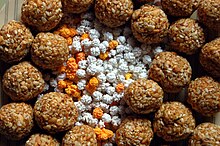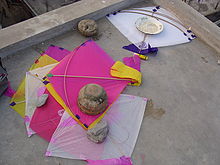makara sankranti in Maharashtra
In Maharashtra on the Makar Sankranti (मकर संक्रान्ति) day people exchange multi-colored halwa (sugar granules coated in sugar syrup) and til-gul ladoos (sweetmeats made from sesame seeds and jaggery). Gulachi Poli (flat bread stuffed with soft/shredded Jaggery mixed with toasted, ground Til (white sesame seeds)and some gram flour which has been toasted to golden in plenty of pure Ghee) are offered for lunch. While exchanging til-gul as tokens of goodwill people greet each other with the words, "तिळगुळ घ्या आणि गोड गोड बोला/til-gul ghya, aani god god bola" meaning ‘Accept these tilgulsand speak sweet words’. The underlying thought in the exchange of til-gul is to forget the past ill feelings and hostilities and resolve to speak sweetly and remain friends.
This is a special day for the women in Maharashtra when married women are invited for a get-together called ‘Haldi-Kunku’ (literally meaning turmeric and vermillion) and given gifts such as utensil, clothes, etc. Typically, women wear black sarees or black coloured outfits on this occasion. The significance of wearing black is that Sankranti comes at the peak of the winter season and black colour retains and absorbs heat, helping keep warm.[citation needed] Maharastra is also famous for kite flying on this special occasion.
Makar Sankranti is one of the most auspicious days for the Hindus and is celebrated in almost all parts of India in myriad cultural forms, with great devotion. Millions of people take a dip in places like Ganga Sagar (the point where the river Ganges meets the Bay of Bengal) and Prayag and pray to the Sun God (Surya). It is celebrated with pomp in southern parts of India as Sankranti (Pongal in Tamil Nadu), and in Punjab as Maghi.
In the western Indian state of Gujarat, the celebrations are even bigger. People offer thousands of their colorful oblations to the Sun in the form of beautiful kites. The act stands as a metaphor for reaching to their beloved God, the one who represents the best. In the rural and coastal areas, cockfights are held and is a prominent event of the festival. Makar Sankranti is also to honour, worship and to pay respect to Saraswati (Goddess of Knowledge). At the start of this significant event, there is also worship for the departed ancestors.
Makar Sankranti identifies a period of enlightenment, peace, prosperity and happiness followed by a period of darkness, ignorance and viciousness with immense sorrow. The six months of northern movement of the sun is followed by six months of southern movement.
Since the festival is celebrated in mid winter, food prepared for this festival is such that it keeps the body warm and gives high energy. Laddu of til made with Jaggery is a specialty of the festival. In the western Indian state of Maharashtra it is called 'Tilgul'. In Karnataka it is called 'Yellu-Bella'. In some states cattle are decorated with various colours and are made to jump over a bon-fire.

